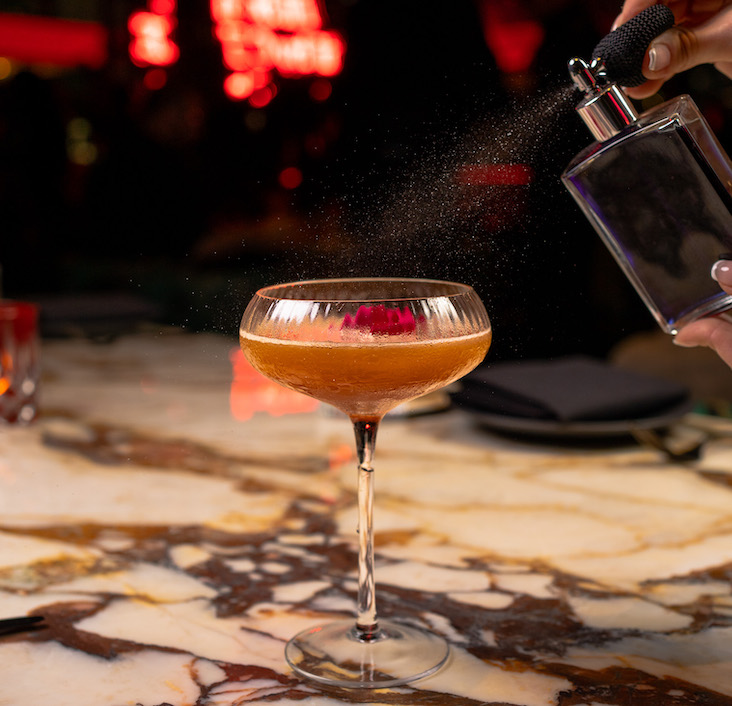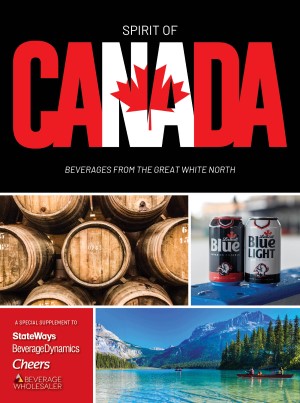OVER HALF OF ALL AMERICAN HOUSEHOLDS BUY BOTTLED WATER . . . AND THOSE AMERICANS ARE BEGINNING TO LOOK FOR IT WHEN THEY GO OUT, TOO.
Bottled water continues its surge as the fastest growing beverage category in the U.S. Sales boomed by 14% last year to reach $4.9 billion dollars, according to Beverage Marketing Corporation, a Manhattan-based information, consulting and financial-services firm.
And that’s nothing, according to suppliers. “Here in the United States, people consume 57 liters per person [annually],” explains Kimberly Newhart, director of national accounts for foodservice for the Perrier Group. “It’s 144 liters per person in Europe. We’re not even close to what a mature bottled-water market could be in the United States.”
Yet.
“Consumers are getting bottled water in all different avenues in their lives, in convenience stores, when they shop at club stores, in the office cafeteria,” says Newhart, “and when they dine out in the evening, whether that’s at Le Bec-Fin or Applebee’s or Morton’s or Burger King, they are beginning to look for and expect bottled water.”
Indeed, Newhart just recently established a relationship with Burger King, supplying that fast-food chain with Perrier’s regional bottled-water brands. In quick-service restaurants (QSR’s), she explains, about 24% of all customers leave without ordering a beverage. Perrier and Burger King are betting that at least some of these customers are doing so because, up until now, those fast-food restaurants haven’t been offering what they wanted: bottled water. “We don’t expect to get all 24%,” says Newhart, “but even if we just get 10%, that’s 25 to 30 bottles a day in an average QSR.”
Granted, most of the growth in the bottled-water market is coming from non-restaurant business, specifically sales of still waters in smaller PET, or plastic, bottles in convenience and grocery stores. For that type of water, sales are growing by rates of 30% to 40% annually.
At upscale operations like Morton’s (right), sparkling water is favored.
Indeed, the bottled-water business in full-service restaurants is very different from the rest of the market for the beverage. While the bulk of bottled water sales generally is in the form of still water in single-serve PET bottles, in full-service restaurants, the majority of sales are of sparkling brands, the packaging of choice is glass and the most popular size is the liter bottle.
While health concerns are a common motive for people buying bottled water in retail settings they are concerned with the quality of their tap water or they would rather not drink soda in full-service restaurants, especially fine-dining ones, customers often order bottled-water because of a long-standing tradition.
“European mineral waters started it,” explains John Stevens, president of Talking Rain Beverage Company, based in Preston, WA. “There are hundreds of years of tradition there, that, in addition to a nice bottle of water, you have mineral water with your meal. It’s a fabulous combination.” Indeed, two of the most popular brands in fine dining, are European imports: the French Perrier and the Italian Pellegrino, both now owned by the Perrier Group.
BUBBLES, ANYONE?
Why sparkling? “It isn’t as heavy, it’s more refreshing and it’s lighter on the stomach,” explains Ken Frank, chef/owner of La Toque in Rutherford, CA. Often, the majority of diners in a white-tablecloth restaurant will order bottled water. “I’d say that 60% to 70% of our diners order bottled water and they order sparkling over still by at least two to one,” reports Paul Grieco, beverage director at Gramercy Tavern in New York City.
While sophisticated diners will know of the tradition of serving sparkling mineral water with a meal, even customers with less knowledge will pick sparkling over nonsparkling in a full-service restaurant setting. “They figure, if they’re not going to order sparkling, then they might as well get tap water,” explains Jim Dodson, food & beverage controller for Morton’s of Chicago.
Ken Frank, chef/owner at La Toque, Rutherfored, CA, includes bottled water in his five-course, prix fixe dinners.
Why should operators care bout bottled water? “With bottled water, there’s 70% to 85% profitability,” points out Perrier’s Newhart. “Restaurants, depending on how they mark-up, make $5 per bottle. Minimum. In a business with tight profit margins, if restaurants train their people to sell bottled water, it can significantly affect their entire profitability.” Generally, the prices charged for a liter of bottled water in full-service restaurants range from $3, in a casual restaurant, to as much as $12 for a fine-dining setting.
Indeed, one restaurateur thinks operators can make too much money on bottled water. “I just think it is petty of restaurants to tack exorbitant amounts of money onto the bill for water,” said La Toque’s Frank. Like many fine-dining establishments, La Toque serves but does not charge for bottled water. La Toque also does not charge its diners for coffee. Rather, Frank considers those beverages to be covered by the charge for his restaurant’s five-course, prix-fixe menu: $69 per person.
“Honestly, I don’t think that many people pay attention to the fact that we don’t charge,” he admits but also notes, “We don’t have anyone leaving pissed off because of how much money they spent for water either.”
ALL WET
In a review of a new restaurant she thought showed promise, Phyllis Richman of the Washington Post recently wrote that because the food was good, she was “willing to put up with a waiter who makes me feel like a cheapskate for ordering tap water.” Restaurateurs, most of whom don’t have the luxury of not charging for their bottled water, are, of course, concerned about the possibility of offending their customers this way. After all, Americans are used to drinking their tap water and having it offered to them gratis in restaurants.
Therefore, most operators use low-key techniques for offering bottled water to their customers. The first, obvious step: do not automatically fill water glasses with tap water. “Many restaurateurs feel that customers need to be recognized and greeted immediately and they do that by sending someone over with a water pitcher,” notes Perrier’s Newhart. “But the greeting doesn’t have to be water. It could be offering the menus, putting down some fresh, hot bread or you could greet customers by asking what they would prefer, bottled sparkling, bottled spring or tap water.”
These days, too, most restaurant operators do not go overboard when it comes to the number of brands offered. In part, this is because of consolidation in the bottled-water industry. While at one time there were about 800 brands of bottled water available in the United States, these days, the real business has boiled down to a few national and regional brands. “While there are still hundreds of brands available, the market is really controlled by the top 10 or 20,” says Talking Rain’s Stevens. Most restaurants with bottled water offer just two: a sparkling and a still. Many restaurateurs go with known brand names. La Toque, for example, serves Pellegrino as its sparkling and Evian as its still water. “Having recognized names doesn’t hurt,” says Frank, “and these also happen to taste great.”
And, points out Michael Neuwirth, director of corporate communications for Great Brands of Europe, the company behind the Evian, Volvic and Dannon water brands, “When you offer well-recognized brands, your customers aren’t left wondering what they just ordered.”
Of course, taste is a factor. At Gramercy Tavern, the bottled waters offered were chosen on the basis of a taste test. The restaurant offers Lurisia, a sparkling water from Northern Italy, and Evian.
And some restaurants have fun with their bottled-water choices. At Nicole’s in New York City, for instance, the bottled water offered is called Hildon. This relatively unknown brand was chosen because its blue bottles go well with the restaurant’s decor, not a small consideration for a restaurant that is an extension of a stylish clothing store called Nicole Farhi, and because the water, like the clothing, is an English import.
“It’s actually a very easy product to sell,” says Thea Hencher, manager, who notes that the restaurant serves more bottled water than tap. “Here, in New York, we’ve found that people order Pellegrino by name,” she continues. “We make a point of telling them that ours is an English water. People respond well; they like to try new things.”
As with selling any item in a restaurant, product knowledge can come in handy. “Know the waters, what they are, where they’re from,” says Great Brands’ Neuwirth.
COLD TIPS
Of course, bottled water should be served chilled. “And without a garnish,” says Neuwirth. “One reason people order it is that you don’t need to mask its taste, the way you do with tap water.” Likewise, it should be served either without ice or with cubes made with the bottled brand.
Water company spokespeople do say that restaurants overlook a few things when it comes to bottled water. Many, for instance, neglect to list their bottled water brands on their menus. Listing the brands and their prices, Newhart notes, “gives people the chance they need to decide.”
Another overlooked avenue: the bar. “With people’s concerns about DUI laws, while they may have a cocktail and a glass of wine with their meal, they also might want to end the evening with [bottled water],” says Newhart. “It allows them to still be sociable.”
Indeed, Perrier believes that the wave of the future in restaurants and bars may be to use bottled water instead of tap water when mixing drinks. The company has encouraged operators to create drinks, both with and without alcohol, that use Perrier. (See sidebar.) Meanwhile, at La Toque, children are served Pellegrino flavored with syrups. And Evian’s Neuwirth points to the possibility of using bottled water for the water backs served with liquors such as single-malt Scotch.
In other words, when it comes to serving bottled water in restaurants, it’s water, water everywhere
WHEN WATERED-DOWN DRINKS ARE GOOD
The Perrier Group recently asked bartenders from some of the hottest clubs and bars in the country to create drinks made with Perrier. Some of the results:
NAPOLEON
from Shine in New York
1 oz. amaretto
1 oz. peach schnapps
splash of orange juice
4 oz. Perrier
garnish with an orange twist
In a cocktail shaker, mix amaretto, schnapps and orange juice over Perrier ice. Pour into an old-fashioned glass and top off with 4 ounces of Perrier and garnish with an orange twist.
PERRIER SLICE
from Jimmy’z at The Forge in Miami
3 oz. lemon-flavored rum
1 oz. triple sec
1 oz. cranberry juice
1 oz. orange juice
1 oz. Perrier
garnish with orange, lemon and lime slices
In a cocktail shaker with Perrier ice, add rum, triple sec and juices. Mix well, pour into an 8-ounce highball glass and top off with Perrier. Garnish with fruit slices.
PERRIER ICEBERG
from Hugo’s Frog Bar and Fish House in Chicago
2 scoops lemon sorbet
5 oz. Lemon Perrier
In a cocktail shaker, mix one scoop of the sorbet with the Perrier. Shake well and pour into a small parfait glass. Add a small scoop of lemon sorbet, letting it float on top like an iceberg. Serve immediately.
left: Napoleon | right: Perrier Slice
Copies of “Refreshing Drinks from America’s Hottest Bartenders,” a brochure, can be obtained from Perrier by calling 877-POUR-IT-ON (877-768-7486), extension 25.




